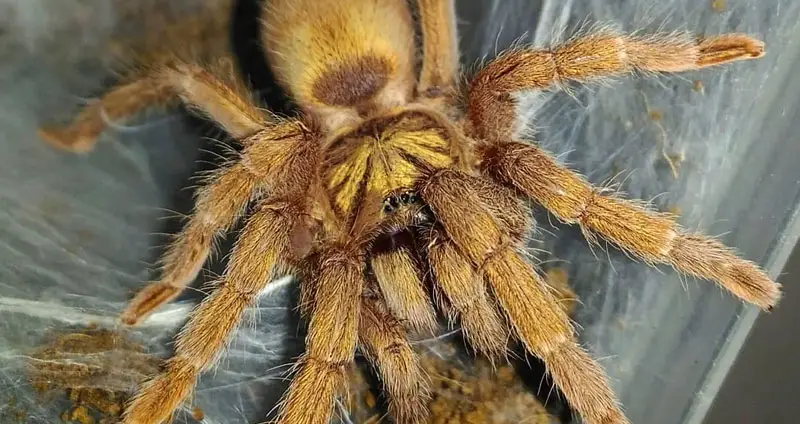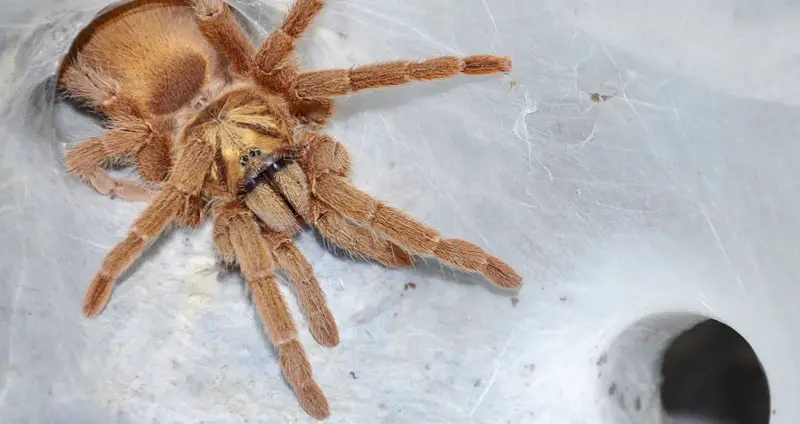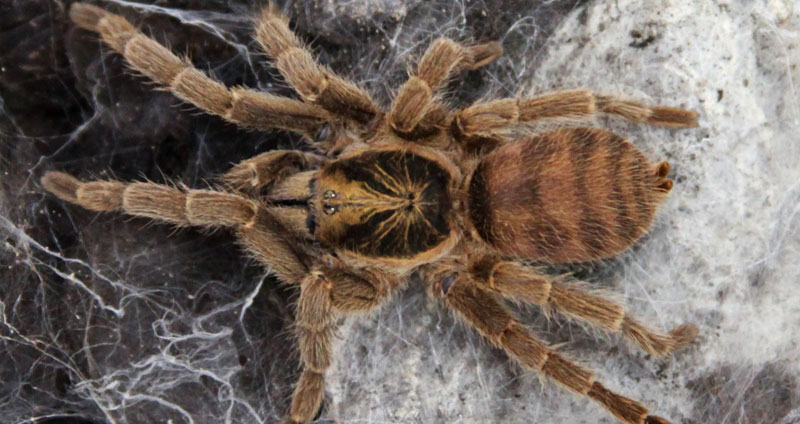Neoholothele incei, also known as the Trinidad Olive Tarantula, is definitely one of the more interesting tarantulas in the hobby due to its unique appearance and personality.
Due to the fact that it’s a communal species, many tarantula keepers don’t just have one of these — they have several!
Learn all about how to care for this interesting tarantula in regards to its enclosure, diet, and everything in-between.
Table of Contents
Neoholothele incei Care Sheet
Common Name |
Trinidad Olive |
Species Type |
New world terrestrial |
Habitat |
Native to the Caribbean, Trinidad, and Venezuela where temperatures and humidities are high year-round. |
Growth Rate |
Fast growth rate, reaching maturity in just a few short years. |
Adult Size |
Females can reach up to 3″ in legspan, while males usually measure slightly smaller. |
Lifespan |
Females are estimated to live around 10 years, while males only live for about 3. |
Enclosure |
A communal tarantula that can live with several others of its species. If it’s kept alone, enclosures don’t need to be large. They should have several inches of substrate in addition to a cork bark hide and water dish. |
Temp/Humidity |
75°F to 80°F with about 60% to 70% humidity. |
Diet |
Good eater that can eat 2 adult crickets per week or a single dubia roach. Diets can be supplemented with mealworms. |
Temperament |
Tends to be docile and friendly most of the time. However, it can move extremely fast and is relatively unpredictable. Will throw up a threat pose if threatened. Doesn’t have urticating hairs. |
Experience Level |
Intermediate – Not recommended for beginners because of their small size and very fast movements. Communal setups can also be challenging. Other than that, they’re quite easy to care for with basic requirements. |
Average Cost |
Slings ~ $35, Males ~ $50, Females ~ $75+ |
Neoholothele incei Appearance
The appearance of this species isn’t extremely colorful, but it’s certainly unique. In fact, there isn’t just one coloration, or form, of this species — there’s two!
In the trade, you can either find gold form or olive form Neoholothele incei. Gold form is the result of a recessive gene, and it seems to be the favorite among enthusiasts.
The gold form features fairly even gold coloration over its entire body, but with recognizable patterns on its carapace and abdomen.
The olive form, pictured below, has a brown-colored body with dark brown and yellow markings on its legs, carapace, and abdomen.
Both forms have relatively short hair and horizontal stripes across their abdomens.
In terms of sizing, this is considered a dwarf tarantula. Females only reach a legspan of up to 3″, while males often don’t reach 2.5″.
N. incei has a lifespan of only about 10 years for females, though, so this means that they have fast growth rates and reach maturity in just a few short years.

Neoholothele incei Temperament
The temperament of these tarantulas is kind of in a no-man’s-land where it’s friendly but not really recommended for beginner tarantula keepers.
As Neoholothele incei is from the Western Hemisphere, it’s classified as a new world tarantula. These tarantulas are known for their more docile nature and preference to run away from danger as opposed to fighting it.
For the most part, this species isn’t an exception to this classification. They tend to be friendly towards their owners and don’t commonly throw threat poses.
However, they aren’t necessarily calm.
Many owners describe their N. incei as skittish and willing to bolt, so accessing their enclosure or manipulating them may be difficult. It’s for this reason that they’re not recommended as a first tarantula, especially if handling is important.
Inside their enclosure, though, this species is really something else.
Being a communal species, they’re able to live with several others of their own species. Cannibalism can happen, but it’s a lot less common with this species.
Additionally, they have the tendency to create absolutely stunning webs all over the insides of their enclosure, making them one of the best webbing species out there.
Housing Neoholothele incei
Housing one of these tarantulas is quite simple, and only takes a few considerations.
All that you need to do is provide it with an optimal enclosure, add a few necessary accessories, and keep the internal climate consistent. That’s about it!
Optimal Enclosure
This is a terrestrial species, meaning that it spends its time on the ground and creates burrows down into the substrate. Therefore, their enclosure needs to reflect this.
The standard terrestrial tarantula enclosure has more of a focus on floor space than height, provides plenty of substrate for burrowing, and provides lots of free space.
If you’re housing this tarantula alone, you can opt for a smaller enclosure like the Exo Terra 12″ x 12″ x 12″ terrarium.
Communal setup enclosures need to be larger so that all of the spiders don’t feel cramped. In this case, an upgrade to the Exo Terra 18″ x 18″ x 12″ terrarium is recommended.
Both of these enclosures offer plenty of floor space while remaining accessible, secure, and breathable while also promoting great visibility.
Enclosure Decorations
The inside of the enclosure also needs a few considerations. However, Neoholothele incei generally needs fewer accessories than most other tarantulas! Why is that?
Remember, this species produces beautiful, intricate webs all over the insides of their enclosure. Because of this, you want to leave a lot of their enclosure open to allow this behavior.
Too many accessories limits the webbing that they can create.
So, first and foremost you’ll want to layer about 4″ of moisture retaining substrate, like coconut fiber, on the floor of the enclosure. This provides a soft base in addition to keeping the enclosure clean and humid.
On top of that, you only need to include two accessories: a cork bark hide and a water dish.
The cork bark hide is a great place for a tarantula to hide out in when they feel stressed/threatened, and water dishes prevent dehydration while also contributing to the enclosure’s humidity.

Enclosure Temperature/Humidity
Neoholothele incei is endemic to the Caribbean, Trinidad, and Venezuela, which are generally hot and humid year-round. Therefore, their enclosure should mimic this climate, but it doesn’t need to be exact.
The optimal temperature for this species is around 75°F and 80°F. For most people, this is right around room temperature, so supplemental heating shouldn’t be necessary.
If your house drops below this range consistently, you should keep it a bit warmer through either a space heater or a gentle heat lamp that doesn’t emit any light.
As for humidity, aim for around 60% to 70%.
This range is simple to maintain by keeping the water dish clean/filled and by misting one side of the enclosure about 2-3 times per week.
It’s recommended that you use a simple thermometer/hygrometer to monitor the climate within the enclosure so that you can make small changes as needed.
Diet
The diet of this tarantula isn’t much different from a normal tarantula diet — it’s essentially just downsized.
As spiderlings, Neoholothele incei should be offered flightless fruit flies or pinhead crickets as frequently as it’s willing to eat — usually around 2-3 times per week.
Juveniles can eat larger crickets about twice a week, and adults can eat about 3 larger crickets per week.
Every tarantula is different with their feeding, though, so be sure to observe your particular tarantula and adjust your feeding accordingly.
Additionally, if you’re housing communally, it’s very important that you provide enough food. If you don’t N incei. won’t hesitate to resort to cannibalism.
Always err on the side of caution with food!
Health Concerns
Fortunately, pet tarantulas rarely experience health problems due to the presence of a comfortable environment and steady diet. There are a couple things that owners need to note, though.
First of all, the two most common health problems that captive tarantulas experience are dehydration and mites. Both of these issues are easy to cure or simply prevent altogether, though.
Additionally, if you’re housing Neoholothele incei communally, you need to put some extra care into things.
Provide them with a larger enclosure, supply more food per week, and if you witness any violence or cannibalism, separate your tarantulas immediately!
While many owners don’t have problems with their communal setup, they can occur. It’s your job to make the necessary changes to keep all tarantulas happy and healthy.
Neoholothele incei For Sale & Price
If you’re looking to purchase Neoholothele incei, you’re in luck — they’re very affordable tarantulas to buy. They’re common, relatively easy to breed, and well-liked by many, so they fetch cheaper prices.
You can find a healthy spiderling for sale on a variety of different forums and marketplaces for right around $35. Mature males sell for a little more than this, and mature females sell for around $100 or so.
Of course, there are other costs of tarantula ownership that you’ll incur, but this is still a very affordable price for a tarantula.
So, in conclusion, Neoholothele incei is an excellent tarantula that everyone should consider for their collection. They’re small, look great, can live communally, and are easy to care for.
Sure, they may not be the most calm tarantula ever, but that’s what makes it so much fun to own!


